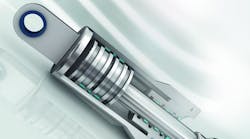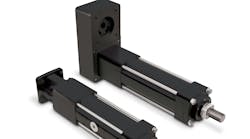Download this article in .PDF format
This file type includes high resolution graphics and schematics when applicable. | Is the new fluid compatible with the existing fluid? Mixing fluids that are not compatible may cause filtering, defoaming, and water separation issues to name a few. The general result is a fluid that is less than the sum of its parts. Some additives in one formulation can indeed negate the function of additives in the other formulation.
Is the new fluid compatible with existing seals? Determine early in your design process the compatibility of currently familiar seal materials to avoid setting up a situation in which you have no choice but to make drastic changes to your seal supply or seal design. Availability and cost are major drivers in seal selection, and having an unplanned change of materials can greatly reduce your options. Seal compatibility goes far beyond a 70-hr soak test, although this is a good place to start if no data is available.
A soak test that bathes the seal material in the test fluid is conducted, and a comparison of the physical properties of the material before and after the soak is made. These soak tests are best conducted at temperatures at or near the range maximum. If chemical interactions result in tensile or swell of the material, it is a good idea to test for longer durations.
Make intermediate measurements during the process in order to determine the point when the material reaches an equilibrium point regarding its chemical interaction with the fluid. Many fluid-seal material interactions may not reach equilibrium or disqualifying property degradation in a 70-hr test.
Do you know what material you are using? When specifying the seal material for your particular application make sure that you have specified more than the base polymer. 70 Shore A NBR is no more a material compound than HETG (vegetable oil-based fluid) is a fluid recipe. For many applications in the world of the familiar, specifying a 70 Shore A NBR O-ring works just fine. However, if experience with the fluid is not supplying an acceptable amount of confidence, specifying a compound recipe is recommended. Even though a fluid supplier makes a claim of compatibility with NBR, and the NBR supplier makes a claim of compatibility HETG fluids, it does not mean that there could be a wide range of results when testing the compatibility of randomly chosen recipe combinations. The interactions of seal materials and hydraulic fluids are very complex, and very different results can occur based on the interacting chemistries.
For NBRs, different types of fillers, processing agents, homogenizers, plasticizers, and vulcanizing agents are used to produce a 70 Shore A NBR, and a similar situation holds true for an HETG fluid in regards to the types additives chosen. In the end, it is the chemical interactions in the additives of each that can lead to physical breakdown of the seal material(s). Complicating matters further for the system designer, fluid manufacturer, and seal manufacturer is the fact that many of the important details of these compounds, which might help a chemist make a definitive prediction on compatibility, are not shared because they are proprietary.
The answer to this confounding dilemma is actually simple. When a suitable material is found, make sure that material is identified to a specific compound recipe.
Upward Trend for Gas and Oil Exploration
One of the biggest applications for biodegradable fluids is in oil and gas exploration and production. Fluid suppliers have responded by introducing new, eco-friendly biodegradable and non-toxic fluids based on a variety of different chemistries. What is needed is not only a sealing solution that can handle the fluid, but also all the other demanding parts of that application, such as salt water, storms, various tidal and freezing conditions.
In critical operations, these systems need to be in operation 24 hours continuously; any downtime is very costly. Seal manufacturers have responded to this trend by ensuring their seals are able to interact appropriately with these new greener fluids, which very often do not have the best lubricating properties. Oil and gas exploration applications continue to be complicated due to economic pressures that are moving the industry toward higher operating pressures, temperatures, and working cycles—all of which are more efficient, but also increase the stress on components such as seals and lubricants.
In addition, government regulations aimed at protecting the environment must be considered for those who design, build, or use hydraulic systems. With this in mind, it is important to understand the entire sealing system, gather all customer requirements, and evaluate the application. Specifically, a shoulder-to-shoulder design engineering approach where collaboration between the seal supplier and the customer’s application engineers makes a difference in delivering substantial
added value and a total value of ownership advantage.
Conclusions
Seal suppliers and hydraulic equipment manufacturers must be knowledgeable of chemical compatibility requirements and test methods. Working with material suppliers that understand these challenges and are able to perform the proper testing to ensure compatibility is imperative for a smooth transition.
In addition to compatibility, suppliers should also know how to extend advantages received with standard hydrocarbon-based fluids such as a longer operating life of the seal, lower friction and reduced energy consumption, enhanced sealing techniques, and the delivery of a total value of ownership.
Joe Savina is a fluid power application engineer at Trelleborg Sealing Solutions, Fort Wayne, Ind.


